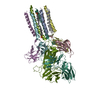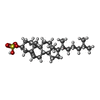+ Open data
Open data
- Basic information
Basic information
| Entry | Database: PDB / ID: 7fjf | ||||||
|---|---|---|---|---|---|---|---|
| Title | Cryo-EM structure of a membrane protein(CS) | ||||||
 Components Components |
| ||||||
 Keywords Keywords | IMMUNE SYSTEM / membrane / immune | ||||||
| Function / homology |  Function and homology information Function and homology informationregulation of lymphocyte apoptotic process / gamma-delta T cell receptor complex / Fc-gamma receptor III complex / T cell anergy / positive regulation of cell-cell adhesion mediated by integrin / T cell activation involved in immune response / positive regulation of T cell anergy / Fc-gamma receptor signaling pathway / gamma-delta T cell activation / CD4-positive, alpha-beta T cell proliferation ...regulation of lymphocyte apoptotic process / gamma-delta T cell receptor complex / Fc-gamma receptor III complex / T cell anergy / positive regulation of cell-cell adhesion mediated by integrin / T cell activation involved in immune response / positive regulation of T cell anergy / Fc-gamma receptor signaling pathway / gamma-delta T cell activation / CD4-positive, alpha-beta T cell proliferation / negative thymic T cell selection / positive regulation of CD4-positive, alpha-beta T cell proliferation / alpha-beta T cell receptor complex / positive thymic T cell selection / positive regulation of protein localization to cell surface / signal complex assembly / Nef and signal transduction / positive regulation of cell-matrix adhesion / smoothened signaling pathway / T cell receptor complex / Translocation of ZAP-70 to Immunological synapse / Phosphorylation of CD3 and TCR zeta chains / positive regulation of interleukin-4 production / establishment or maintenance of cell polarity / dendrite development / protein complex oligomerization / alpha-beta T cell activation / Generation of second messenger molecules / FCGR activation / immunological synapse / Co-inhibition by PD-1 / Role of phospholipids in phagocytosis / T cell receptor binding / T cell costimulation / positive regulation of T cell proliferation / endomembrane system / positive regulation of calcium-mediated signaling / positive regulation of interleukin-2 production / FCGR3A-mediated IL10 synthesis / cell surface receptor protein tyrosine kinase signaling pathway / protein tyrosine kinase binding / T cell activation / cerebellum development / FCGR3A-mediated phagocytosis / negative regulation of smoothened signaling pathway / response to bacterium / apoptotic signaling pathway / clathrin-coated endocytic vesicle membrane / calcium-mediated signaling / Regulation of actin dynamics for phagocytic cup formation / peptide antigen binding / SH3 domain binding / positive regulation of type II interferon production / Immunoregulatory interactions between a Lymphoid and a non-Lymphoid cell / cell-cell junction / transmembrane signaling receptor activity / Downstream TCR signaling / Cargo recognition for clathrin-mediated endocytosis / T cell receptor signaling pathway / protein transport / Clathrin-mediated endocytosis / signaling receptor complex adaptor activity / cell body / protein-containing complex assembly / regulation of apoptotic process / dendritic spine / adaptive immune response / cell surface receptor signaling pathway / G protein-coupled receptor signaling pathway / protein heterodimerization activity / negative regulation of gene expression / external side of plasma membrane / positive regulation of gene expression / protein kinase binding / cell surface / endoplasmic reticulum / Golgi apparatus / protein homodimerization activity / identical protein binding / plasma membrane / cytosol / cytoplasm Similarity search - Function | ||||||
| Biological species |  Homo sapiens (human) Homo sapiens (human) | ||||||
| Method | ELECTRON MICROSCOPY / single particle reconstruction / cryo EM / Resolution: 3.1 Å | ||||||
 Authors Authors | Chen, Y. / Zhu, Y. / Gao, W. / Zhang, A. / Guo, C. / Huang, Z. | ||||||
| Funding support |  China, 1items China, 1items
| ||||||
 Citation Citation |  Journal: Mol Cell / Year: 2022 Journal: Mol Cell / Year: 2022Title: Cholesterol inhibits TCR signaling by directly restricting TCR-CD3 core tunnel motility. Authors: Yan Chen / Yuwei Zhu / Xiang Li / Wenbo Gao / Ziqi Zhen / De Dong / Buliao Huang / Zhuo Ma / Anqi Zhang / Xiaocui Song / Yan Ma / Changyou Guo / Fan Zhang / Zhiwei Huang /  Abstract: Cholesterol molecules specifically bind to the resting αβTCR to inhibit cytoplasmic CD3ζ ITAM phosphorylation through sequestering the TCR-CD3 complex in an inactive conformation. The mechanisms ...Cholesterol molecules specifically bind to the resting αβTCR to inhibit cytoplasmic CD3ζ ITAM phosphorylation through sequestering the TCR-CD3 complex in an inactive conformation. The mechanisms of cholesterol-mediated inhibition of TCR-CD3 and its activation remain unclear. Here, we present cryoelectron microscopy structures of cholesterol- and cholesterol sulfate (CS)-inhibited TCR-CD3 complexes and an auto-active TCR-CD3 variant. The structures reveal that cholesterol molecules act like a latch to lock CD3ζ into an inactive conformation in the membrane. Mutations impairing binding of cholesterol molecules to the tunnel result in the movement of the proximal C terminus of the CD3ζ transmembrane helix, thereby activating the TCR-CD3 complex in human cells. Together, our data reveal the structural basis of TCR inhibition by cholesterol, illustrate how the cholesterol-binding tunnel is allosterically coupled to TCR triggering, and lay a foundation for the development of immunotherapies through directly targeting the TCR-CD3 complex. | ||||||
| History |
|
- Structure visualization
Structure visualization
| Structure viewer | Molecule:  Molmil Molmil Jmol/JSmol Jmol/JSmol |
|---|
- Downloads & links
Downloads & links
- Download
Download
| PDBx/mmCIF format |  7fjf.cif.gz 7fjf.cif.gz | 210.9 KB | Display |  PDBx/mmCIF format PDBx/mmCIF format |
|---|---|---|---|---|
| PDB format |  pdb7fjf.ent.gz pdb7fjf.ent.gz | 160.6 KB | Display |  PDB format PDB format |
| PDBx/mmJSON format |  7fjf.json.gz 7fjf.json.gz | Tree view |  PDBx/mmJSON format PDBx/mmJSON format | |
| Others |  Other downloads Other downloads |
-Validation report
| Summary document |  7fjf_validation.pdf.gz 7fjf_validation.pdf.gz | 1 MB | Display |  wwPDB validaton report wwPDB validaton report |
|---|---|---|---|---|
| Full document |  7fjf_full_validation.pdf.gz 7fjf_full_validation.pdf.gz | 1 MB | Display | |
| Data in XML |  7fjf_validation.xml.gz 7fjf_validation.xml.gz | 34 KB | Display | |
| Data in CIF |  7fjf_validation.cif.gz 7fjf_validation.cif.gz | 51.2 KB | Display | |
| Arichive directory |  https://data.pdbj.org/pub/pdb/validation_reports/fj/7fjf https://data.pdbj.org/pub/pdb/validation_reports/fj/7fjf ftp://data.pdbj.org/pub/pdb/validation_reports/fj/7fjf ftp://data.pdbj.org/pub/pdb/validation_reports/fj/7fjf | HTTPS FTP |
-Related structure data
| Related structure data |  31620MC  7fjdC  7fjeC M: map data used to model this data C: citing same article ( |
|---|---|
| Similar structure data | Similarity search - Function & homology  F&H Search F&H Search |
- Links
Links
- Assembly
Assembly
| Deposited unit | 
|
|---|---|
| 1 |
|
- Components
Components
-T-cell surface glycoprotein CD3 ... , 4 types, 6 molecules badefg
| #1: Protein | Mass: 18810.520 Da / Num. of mol.: 2 Source method: isolated from a genetically manipulated source Source: (gene. exp.)  Homo sapiens (human) / Gene: CD247, CD3Z, T3Z, TCRZ / Production host: Homo sapiens (human) / Gene: CD247, CD3Z, T3Z, TCRZ / Production host:  Homo sapiens (human) / References: UniProt: P20963 Homo sapiens (human) / References: UniProt: P20963#2: Protein | | Mass: 18949.537 Da / Num. of mol.: 1 Source method: isolated from a genetically manipulated source Source: (gene. exp.)  Homo sapiens (human) / Gene: CD3D, T3D / Production host: Homo sapiens (human) / Gene: CD3D, T3D / Production host:  Homo sapiens (human) / References: UniProt: P04234 Homo sapiens (human) / References: UniProt: P04234#3: Protein | Mass: 23174.227 Da / Num. of mol.: 2 Source method: isolated from a genetically manipulated source Source: (gene. exp.)  Homo sapiens (human) / Gene: CD3E, T3E / Production host: Homo sapiens (human) / Gene: CD3E, T3E / Production host:  Homo sapiens (human) / References: UniProt: P07766 Homo sapiens (human) / References: UniProt: P07766#4: Protein | | Mass: 20493.457 Da / Num. of mol.: 1 Source method: isolated from a genetically manipulated source Source: (gene. exp.)  Homo sapiens (human) / Gene: CD3G, T3G / Production host: Homo sapiens (human) / Gene: CD3G, T3G / Production host:  Homo sapiens (human) / References: UniProt: P09693 Homo sapiens (human) / References: UniProt: P09693 |
|---|
-T cell receptor ... , 2 types, 2 molecules mn
| #5: Protein | Mass: 30763.717 Da / Num. of mol.: 1 Source method: isolated from a genetically manipulated source Source: (gene. exp.)  Homo sapiens (human) / Gene: TRAV12-3, Tcr-alpha, TRAC, TCRA / Production host: Homo sapiens (human) / Gene: TRAV12-3, Tcr-alpha, TRAC, TCRA / Production host:  Homo sapiens (human) Homo sapiens (human)References: UniProt: A0A0B4J271, UniProt: A0N4Z6, UniProt: P01848 |
|---|---|
| #6: Protein | Mass: 34614.051 Da / Num. of mol.: 1 Source method: isolated from a genetically manipulated source Source: (gene. exp.)  Homo sapiens (human) / Gene: TRBV6-5, TRB, TRBC2 / Production host: Homo sapiens (human) / Gene: TRBV6-5, TRB, TRBC2 / Production host:  Homo sapiens (human) Homo sapiens (human)References: UniProt: A0A0K0K1A5, UniProt: P0DSE2, UniProt: A0A0G2JMB4 |
-Non-polymers , 1 types, 2 molecules 
| #7: Chemical |
|---|
-Details
| Has ligand of interest | Y |
|---|---|
| Has protein modification | Y |
-Experimental details
-Experiment
| Experiment | Method: ELECTRON MICROSCOPY |
|---|---|
| EM experiment | Aggregation state: PARTICLE / 3D reconstruction method: single particle reconstruction |
- Sample preparation
Sample preparation
| Component | Name: immune system / Type: COMPLEX / Entity ID: #1-#6 / Source: RECOMBINANT |
|---|---|
| Source (natural) | Organism:  Homo sapiens (human) Homo sapiens (human) |
| Source (recombinant) | Organism:  Homo sapiens (human) Homo sapiens (human) |
| Buffer solution | pH: 8 |
| Specimen | Embedding applied: NO / Shadowing applied: NO / Staining applied: NO / Vitrification applied: YES |
| Vitrification | Cryogen name: NITROGEN |
- Electron microscopy imaging
Electron microscopy imaging
| Experimental equipment |  Model: Titan Krios / Image courtesy: FEI Company |
|---|---|
| Microscopy | Model: FEI TITAN KRIOS |
| Electron gun | Electron source:  FIELD EMISSION GUN / Accelerating voltage: 300 kV / Illumination mode: FLOOD BEAM FIELD EMISSION GUN / Accelerating voltage: 300 kV / Illumination mode: FLOOD BEAM |
| Electron lens | Mode: BRIGHT FIELD |
| Image recording | Electron dose: 60 e/Å2 / Film or detector model: GATAN K2 QUANTUM (4k x 4k) |
- Processing
Processing
| CTF correction | Type: PHASE FLIPPING AND AMPLITUDE CORRECTION |
|---|---|
| 3D reconstruction | Resolution: 3.1 Å / Resolution method: FSC 0.143 CUT-OFF / Num. of particles: 1028575 / Symmetry type: POINT |
 Movie
Movie Controller
Controller





 PDBj
PDBj
















